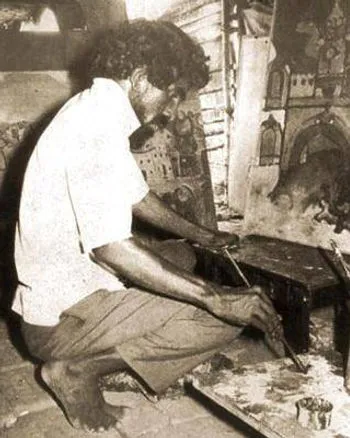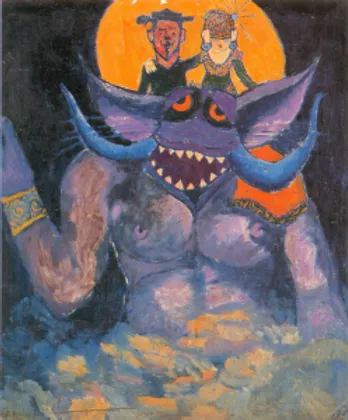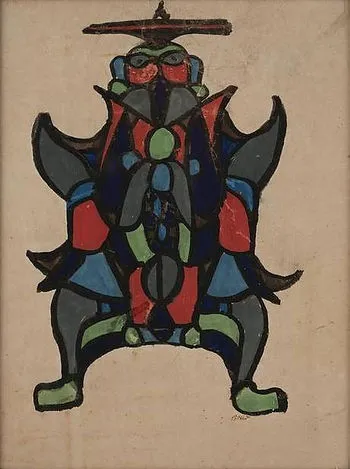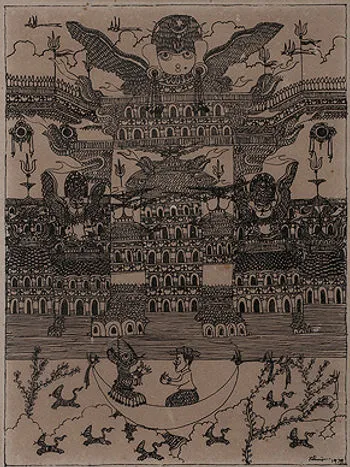The Creative Mind Behind the Canvas
An artist’s process is an intricate blend of technique and introspection, with every brushstroke, color choice, and composition reflecting a deliberate narrative. While artistic practice often incorporates perspective, anatomy, and even socio-political commentary, it is impossible to separate the creator from their creation. Every piece carries a fragment of the artist’s essence, offering a gateway into a deeply personal, often surreal world shaped by their perceptions and experiences.
For K. Ramanujam, art was more than a craft—it was an escape. His works, teeming with dreamlike imagery and symbolic depth, captured an internal universe that was both fantastical and intensely intimate.
Early Life and Artistic Beginnings

Born in 1941 in Tiruvallikeni (now Triplicane), K. Ramanujam grew up in an orthodox Iyengar family with limited means. His childhood was marked by adversity, struggling with schizophrenia and depression. A speech impediment and a frail physique subjected him to ridicule, making him an outsider in his own community. As a young boy, he survived by selling simple ink sketches, using art as both a livelihood and a refuge.
His mother, recognizing his passion, enrolled him in the Government School of Arts and Crafts (now the Government College of Fine Arts) in Chennai. Under the mentorship of K. C. S. Paniker, he honed his skills, channeling his vivid imagination into intricate compositions. Every painting became a visual record of his dreams, serving as a blueprint for an alternate reality—one far removed from the isolation he faced in life.
A Unique Artistic Identity

Ramanujam’s work defied conventional classification, blending elements of Indian mythology, personal symbolism, and the Western Baroque aesthetic into a singular style. His approach aligns with the concept of ‘Art Brut’ or ‘Outsider Art,’ a term introduced by French artist Jean Dubuffet to describe art created outside traditional academic frameworks.
His signature style featured elaborate line drawings, predominantly in black and white. Shifting fluidly between ink washes and criss-cross shading, he developed an innovative technique that involved scraping away portions of the medium to create white spaces. This method gave his artwork an ethereal quality, as if his figures emerged from a dreamscape.
Recurring motifs—celestial beings, winged creatures, radiant suns and moons, timepieces, and elaborate patterns—formed the visual language of his art. His own likeness appeared frequently, often dressed in a white shirt and dark trousers, sometimes sporting a mustache and hat, as if orchestrating a surreal spectacle. In one instance, he described his work with haunting poetry:
“An army of nurses came in search of me, and from the shadow of the shells, I looked on them in sadness.”
Mythological and Architectural Inspirations

Ramanujam’s creations were deeply infused with Vaishnavite themes, reflecting an exploration of divine ascent. His paintings often mirrored classical Hindu texts, reinterpreting their narratives through his distinct perspective. The architectural grandeur of South India, particularly temple structures, found echoes in his compositions.
Despite his reclusive nature, his art radiated confidence. Each drawing, portrait, or ink-based composition displayed meticulous attention to detail, revealing his innate craftsmanship. While he remained deeply attached to his cultural roots, his artistic sensibilities transcended tradition, forging a path uniquely his own.
Cholamandal Art Village and Later Years

In his later years, Ramanujam became associated with the Cholamandal Artists’ Village in Chennai, a hub for modern Indian art. Despite his growing recognition, his struggles with mental health intensified. The vibrancy of his earlier work began to give way to melancholic undertones, reflecting his internal turmoil.
Even as his career reached new heights, the weight of his condition grew heavier. Acclaimed Sri Lankan architect Geoffrey Bawa, a great admirer of his work, commissioned him to create three murals for Hotel Connemara in Chennai. He also participated in significant exhibitions, including the 1965 Commonwealth Arts Festival in London, Lalit Kala Akademi’s national exhibitions, and various shows across Mumbai, Chennai, and New Delhi.
Yet, personal demons persisted. In 1973, at the age of 33, Ramanujam died by suicide, leaving behind an unfinished legacy. His final painting bore a haunting message—dark clouds rolling in over an elephant with its trunk raised, while a dog stood nearby. In place of the dog’s face, Ramanujam had unconsciously drawn his own.
A Lasting Legacy
K. Ramanujam’s art was more than a visual experience—it was an emotional and psychological testament to his solitude. His works functioned as both catharsis and self-expression, providing an outlet for the pain inflicted by societal rejection. His free-flowing lines and intricate forms demonstrated an unparalleled mastery, earning him a distinct place in the Madras Art Movement of the 1960s and 70s.
K. C. S. Paniker once compared him to Charles Strickland, the protagonist of Somerset Maugham’s The Moon and Sixpence, a man whose solitary artistic pursuit kept despair at bay. Ramanujam’s unfinished final painting remains a poignant symbol of his journey—one of brilliance, struggle, and an unrelenting search for meaning through art.
References
- (1979). Artists of Cholamandal Artists’ Village Madras. Artists’ Handicrafts Association of Cholamandal Artists Village.
- (1987). Two decades of Cholamandal Artists’ Village. Cholamandal Artists’ Village.
- James, J. (2004). Cholamandal: An Artist’s Village: Oxford University Press
- K. Ramanujam. Jehangir Nicholson Art Foundation, Mumbai.
- K. Ramanujam. Akara Art, Mumbai.
- Fantasy by K. Ramanujam Victoria and Albert Museum, London.
- K. Ramanujam. Osianama.
- Drawings and Prints from the Museum of Madras Movement. Google Arts and Culture.
- K. Ramanujam. DAG Gallery, Mumbai.
- Decoding the Madras Art Movement, DNA
